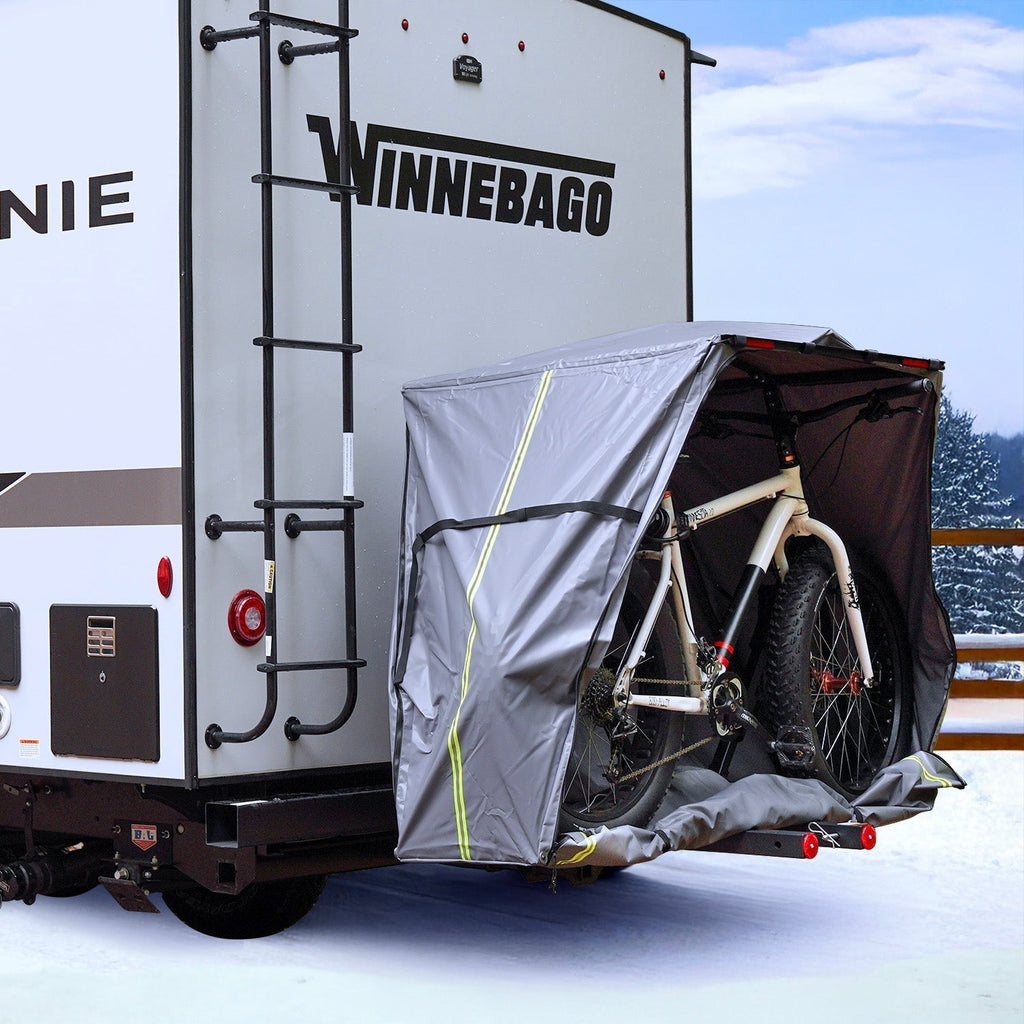Author: Amanda Kennedy
Published: January 30, 2025
Updated: January 31, 2025


Whether you're riding a traditional mountain bike or a fat bike designed for winter adventures, transporting your bike in these harsh conditions comes with unique challenges. Winter-proofing your bike transport ensures your gear stays protected, functional, and ready for any adventure. In this guide, we’ll share expert tips and gear recommendations to help you safeguard your bike during the colder months.
Winter weather can wreak havoc on your bike’s components. Snow, rain, and freezing temperatures can cause water to seep into joints and mechanisms, leading to rust and corrosion. Road salt, used to combat icy conditions, can further accelerate wear and tear, damaging delicate finishes and mechanical parts.
Without adequate protection, your mountain bike might suffer:
Fat bikes, often used for winter biking due to their oversized tires designed for snow and sand, are just as susceptible to these risks. Despite their rugged build, they also require proper winter-proofing to maintain peak performance.

Before transporting your bike, ensure it’s clean and prepped:
Sensitive components like bearings, suspension, and cables require extra care:
Mountain and fat bikes face more dirt, grime, and wear due to their use on unpaved roads and rugged terrain, making regular cleaning and lubrication essential. However, the transport tips and gear in this guide—whether for mountain, fat, or road bikes—apply universally, ensuring all bikes stay protected during winter travel.
Secure your bike to prevent movement during transport:
For heavier bikes like e-bikes or fat bikes, securing their larger frames and bulky load properly down tight is essential to prevent damage during transit.
Proper gear is essential for transporting your bike safely and winter-proofing against harsh conditions. Here’s a breakdown of the main options, their pros and cons, and standout recommendations.

Simple mountain bike transport bags are a budget-friendly option for transporting bikes, but they have limitations. These lightweight options may work for a single trip or occasional use, but their thin materials can tear in windy or rough conditions. For short-term needs, a simple bike bag can work great, but be prepared to invest in higher-quality options for repeated use or harsher conditions.
Pros:
Cons:
TIP: Use bungee cords to tie-down loose areas of the bike bag fabric especially when the bikes are in the back of a pick-up truck bed or mounted on a vehicle trailer hitch as those areas can be especially susceptible to harsh wind damage.

Covered bike carriers feature built-in or custom covers for long-lasting protection against winter weather. These carriers are made with weatherproof materials, heavy-duty zippers, and are designed for durability. Bike Cover that come with covers offer significantly better protection than simple bags and are a reliable solution for frequent or long-distance travel.
Pros:
Cons:
 |
The BikePack enclosed carrier is the ultimate option for covered bike transport. With two doors for easy bike access, LED lights for enhanced visibility, and a slide-out rear hatch for extra storage access, it’s a premium solution designed for convenience and protection. |

Enclosed bike carriers provide the highest level of protection for your bike. These versatile cargo carriers not only shield bikes from winter elements but also offer secure, lockable storage for additional gear. They are a premium choice for bikers who demand durability, security, and convenience.
Pros:
Cons:
 |
The BlackBox carriers offer unmatched weather protection and functionality. With a slide-out rear hatch storage access and large LED taillights, they combine practicality with premium features to ensure your bike and gear arrive in perfect condition, no matter the journey. |
Even with the best winter-proofing, post-transport maintenance for mountain and fat bikers is crucial to keep your bike in peak condition and ready for the next ride. Winter conditions can leave behind salt, grime, and moisture that, if left unchecked, can lead to long-term damage.
Learn More About Indoor Storage

Winter-proofing your mountain bike transport is essential for protecting your investment and ensuring year-round adventures. Whether you’re a fan of traditional mountain bikes, prefer fat bikes for snowy trails, or are a full fledged bikepacker, the right preparation and gear make all the difference. From cleaning and prepping your bike to choosing transport bags and racks designed for winter, these steps will help you conquer the season’s challenges.
Explore Let’s Go Aero’s range of winter-ready solutions, and ride confidently into the colder months!
For more tips and gear recommendations, check out our blog on Protecting Bikes from Winter Snow and Spring Muck.